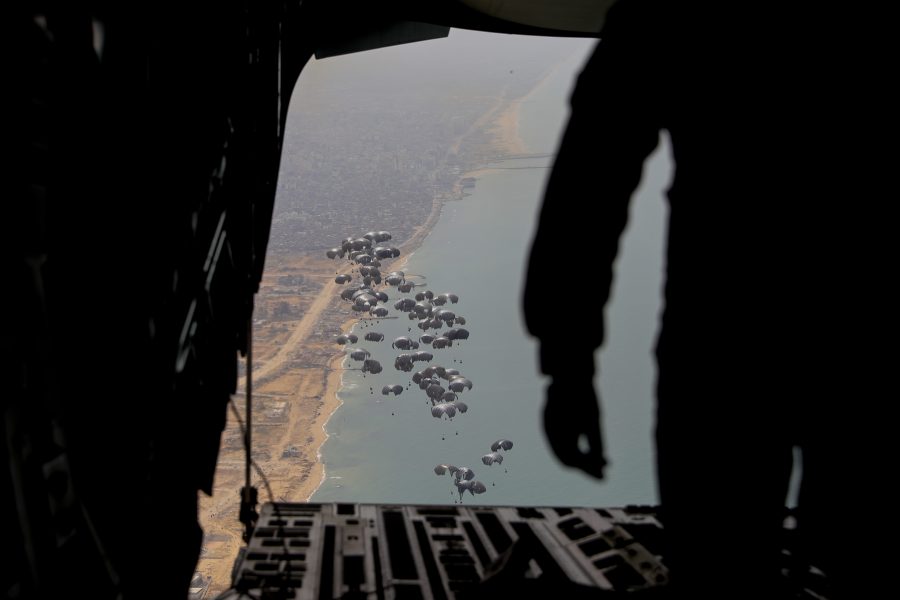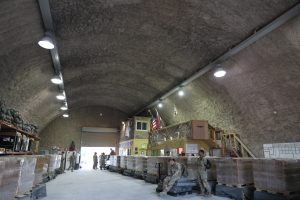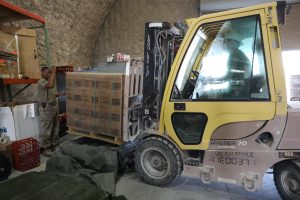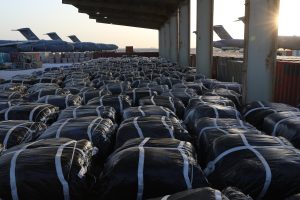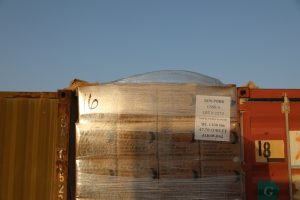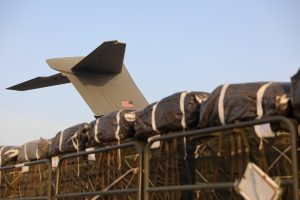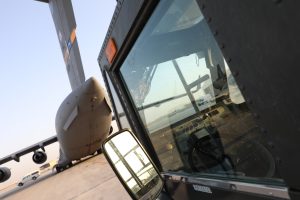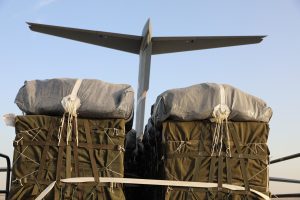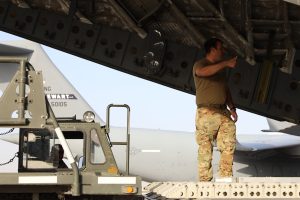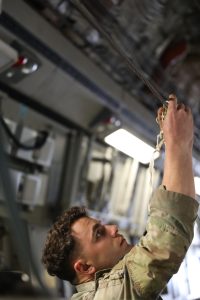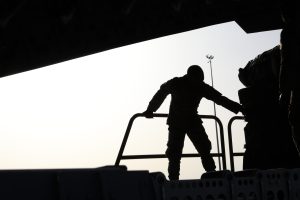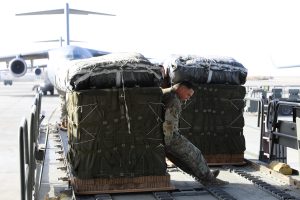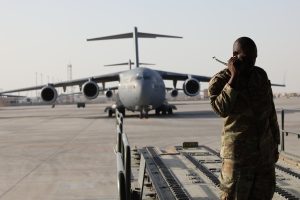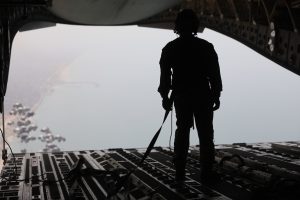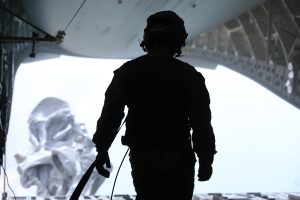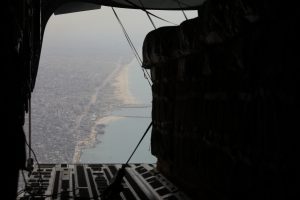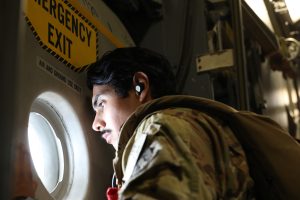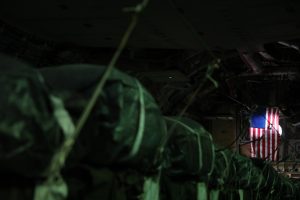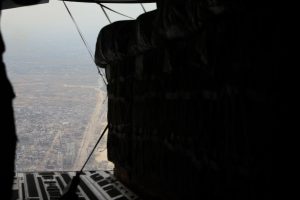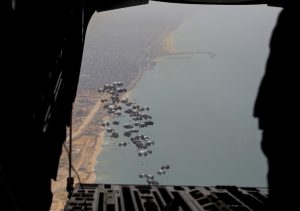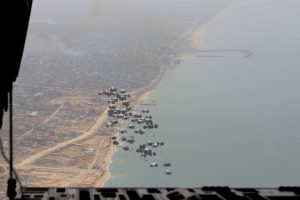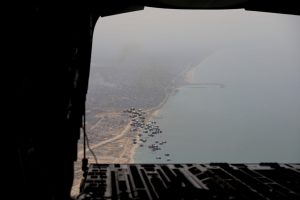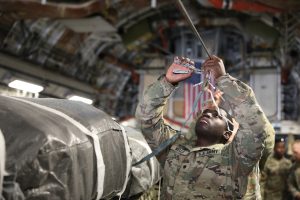OVER THE GAZA STRIP—After three hours in the air, the cargo door of the C-17 slowly opens up, revealing the Mediterranean Sea, the beach, and the ruins of Gaza City on the shore below. Pallets full of MREs tumble out, their parachutes opening to slow their fall to Earth.
The U.S. Air Force and its partners have dropped hundreds of thousands of meals to famished Gazans in recent weeks as efforts to bring in humanitarian aid by land and sea remain stymied. Airmen try to calculate all the variables, from the altitude, to weight, to the effect of the wind, but it’s obvious looking out the back of this massive jet aircraft that airdrops are as much art as science.
Air & Space Forces Magazine joined a March 29 aid mission, which aimed to deliver 46,080 MREs (meals-ready-to-eat) to a drop zone northwest of Al Shifa hospital, the scene of fighting between Israeli troops and Hamas fighters even as the airdrops continue. Two C-17s delivered 80 pallets of food to the Gazans below.
“We’re doing everything we can, as much as we can, as fast as we can,” said Lt. Gen. Alexus G. Grynkewich, the commander of Air Forces Central (AFCENT) and the top air boss in the region, in an interview with Air & Space Forces Magazine.
Hungry Palestinians spied the C-17s in the distance and raced on foot, bicycles, and motorcycles toward the drop site, an open stretch of beach north of a destroyed marina.
Just nine aircrew manned the two C-17s, including an intelligence specialist on each plane to assist with up-to-date imagery. MQ-9s monitored the drop zone below with real-time, full-motion video.
Cargo falls 28.5 feet per second, so forecasting wind is crucial to ensure pallets don’t land on rooftops, or, worse, the hungry people scrambling for food.
“We rely on the intelligence and weather data from staff weather officers in the Air Force, and the crews do the pre-flight and in-flight calculations,” said Army Col. Brian Olson, operations officer for the 1st Theater Sustainment Command, which provides materiel support for the joint force throughout U.S. Central Command (CENTCOM).
The cargo door opened for just three minutes, more than enough time to release the pallets inside. Airdropping relief is not precision warfare. Without guidance systems, crews can try to predict conditions, but they can’t ensure pin-point delivery. On this day, winds proved lighter than expected, and 26 of the 80 bundles drifted into the sea. Some, perhaps most, may wash up on the beach and be salvaged, and the hungry often take to the waves to try to retrieve them.
There will be many more airdrops to come.
After the drop, the aircraft turned towards the Mediterranean Sea, the previously tightly packed C-17 cargo bay suddenly feeling empty, even cavernous as the journey home to Al Udeid Air Base, Qatar, began. The next day, AFCENT C-130s flying out of Jordan made another airdrop.
The Best Option Available
After Hamas attacked Israel on Oct. 7, killing about 1,200 civilians and taking some 250 hostages, the Israeli military invaded Gaza, launching an intensive campaign intended to destroy Hamas, a political and military movement. The fighting has displaced at least one million Gazans and caused an international outcry.
Israel recently promised to increase aid after President Joe Biden called the humanitarian situation in Gaza “unacceptable,” but efforts to mitigate it have proven difficult. On March 2, with the enclave on the brink of famine, the U.S. began airdropping food.
While hardly a panacea for the crisis, the drops are one of the few ways to get aid in now. Trucks could deliver more help, but with only a few land corridors open across the Israeli and Egyptian borders with Gaza and Israel carefully inspecting the flow of supplies, delivering assistance to hungry civilians, as opposed to Hamas fighters, has only gotten more difficult as Gazans have grown hungrier and more desperate.
The U.S. plans to construct a makeshift pier and causeway—called Joint Logistics Over the Shore (JLOTS)—and is sending a flotilla of Army and naval vessels and 1,000 troops to set it up and help get more aid into Gaza from the sea, but establishing that beachhead and causeway will take a month as the flat-bottomed Army boats must first cross the choppy Atlantic at a scant 10 miles per hour. It still remains unclear who will anchor the causeway to land and provide security.
Efforts to negotiate a temporary cease-fire suspending Israeli-Hamas hostilities could facilitate delivery of more aid by land and sea, but no such deal has been forthcoming, leaving the airdrops as among the most critical means of feeding starving civilians. U.S. officials say the Gaza air bridge could become one of the biggest such humanitarian support initiatives since the Berlin Airlift.
“Everyone has seen the challenges with getting aid across the border through the border crossing points,” Grynkewich said. “We’re going keep doing these drops to help the Palestinian people as much as we can until other solutions that can really deliver aid in volume come into play.”
The airdrop initiative had its origins in Jordan, which first conducted an aid airdrop to help resupply a hospital in November and discussed the possibility of expanding that effort with Grynkewich when he visited Amman, Jordan, in early February.
“The Jordanians started reaching out to their allies and partners. Their leadership was very concerned about the suffering in Gaza and the lack of food,” Grynkewich said. “There was some engagement with the U.S. and we wanted to help.”
The U.S. began airdrops a day after President Joe Biden announced the effort on March 1, and in recent weeks, the number of drops has grown exponentially. One month on, C-130s, C-17s, and Airbus A400s from several countries whir over Gaza, with the British the latest to join in.
To boost the effort, C-17s arrived a few weeks ago from Joint Base Charleston, S.C., with crews specially trained in airdrops. Each C-17 can move 40 pallets, far more than the C-130s which carry U.S. and Jordanian-supplied meals. But the C-17s must operate out of Qatar, a roundtrip flight of six hours or more, compared to two hours for a C-130 operating from Jordan.
To facilitate the deliveries, Jordan runs a combined planning cell, including representatives from the U.S. and coalition countries. It coordinates airdrop locations and deconflicts airspace days in advance. The planning process is extensive.
“I’m probably on about 12 different Signal and WhatsApp chats, being geographically separated,” said Maj. Spencer Boone, the mission commander for the March 29 airdrops. “I’m familiar with everything they’re planning,” he said. “I’ll have capabilities on the jet to reach back to a mission planning cell.”
The U.S. mostly drops aid in northern Gaza, where the population is largely cut off from land routes, selecting dropzones that are at least the size of a football field, well clear of structures and roadways.
Prepping the Drop
Not all of the challenges are in the air. The biggest constraint is the availability of humanitarian aid.
“There’s a few things that determine the capacity to drop,” Grynkewich said. “The biggest one is how much humanitarian aid do we have on hand that we can drop.”
At Al Udeid, food and parachutes arrive from America, U.S. bases in the Pacific and Europe, CENTCOM stocks in Kuwait and Iraq, and other locations. The food must be packed into air-droppable bundles and rigged with parachutes.
Rations, which pack 1,000 calories or more into each vacuum-sealed pouch, conform to Islamic dietary restrictions. Finding enough has become a global scavenger hunt. “We’ve had to go all across the world from Japan, Italy,” Olson said. “This has been a daily operation to identify exactly where in the world they are.”
The Army’s setup for rigging the aid at Al Udeid is spartan: an arched steel warehouse, or Nissen hut, surrounded by steel shipping containers. Dozens of aid bundles prepared for future missions are spread out, blocking off a makeshift basketball court with a backboard constructed from an airdrop bundle’s skid board.
Initially, Georgia Army National Guard troops deployed to the region since fall did the rigging; they had been preparing supplies for U.S. troops at forward bases elsewhere. But with demand surging, 28 more riggers recently arrived, doubling capacity.
“They’re partnering with and learning from the group of guys who are here, and they’re going to be together for a while,” said Olson.
Soldiers shuffle the pallets with forklifts, aided by volunteers, among them Guardians from Space Forces Central (SPACECENT), security forces personnel working after completing 12-hour shifts, and dental hygienists, who assemble the aid packages.
Each bundle is assembled on a simple wooden pallet, or skid board, which in turn is topped with two layers of energy-absorbing honeycombed material and then MREs in cardboard boxes. The whole bundle is wrapped in plastic, then wrapped into an A-22 Cargo Bag—a canvas package covered in netting—which Soldiers secure tightly with nylon ties. Parachutes are added to slow the descent of the 1,250-pound pallets to the ground.
“This is the standard configuration that we do for humanitarian aid airdrops,” said Army Chief Warrant Officer 2 Michael Romeo, the head of Detachment 2 of the 165th Quartermaster Company.
“We routinely support troops in forward locations for OIR, and we use the same type of system,” he added, referring to Operation Inherent Resolve, the U.S.-led military campaign against the Islamic State group. “Everything is done with exactly the same care whether it’s going out for a humanitarian aid airdrop, out for a training drop, or out to our forward locations. Everything is real world for us.”
“It’s complex,” Army Staff Sergeant Jacob Engstrom, a parachute rigger with Detachment 2, said later as he stood near the bundles that had been prepared for the next airdrop. “It’s like a vehicle. It’s super easy for you to drive, but the internals of it are what’s complicated.”
At Al Udeid, the packages are then loaded onto a flatbed truck, transferred, rolled up to the back of a C-17, and pushed onboard, usually at night before a daylight flight. When it’s time for the three-hour journey to Gaza, an American flag hangs above the cargo bay outside the cockpit.
Helping ‘Save Lives’
It takes specialists to make these deliveries. Only one-fourth of C-17 pilots are airdrop-qualified aircraft commanders, and only half of C-17 crews have an airdrop-qualified loadmaster or co-pilot. Among them is a loadmaster sporting a kangaroo on his t-shirt, a souvenir from last year’s Mobility Guardian 2023 exercise, where he operated out of Australia, practicing airdrops in the Pacific theater.
Half an hour out, Boone and other Airmen run their last checks. The aircraft creaks as it depressurizes, and the dim green lighting is replaced by bright flood lights. A loadmaster starts removing straps tying down the bundles to the floor.
Untethered, the 25-ton cargo starts to shift in place, rocking back and forth, and the door slowly opens, revealing the beach and sea 3,000 feet below.
As the pallets slide out, the Low-Cost, Low-Velocity parachutes, each one 64 feet in diameter, open up. Designed to move slowly to minimize injuries below, they are less accurate than the high-velocity parachutes used in war zones.
“It’s not screaming down,” Olson said. “In combat, you want our soldiers to get on the ground as quickly as possible. We don’t want these to get on the ground as quickly as possible.”
Designed for a lifespan of 15 years, they won’t be used again. Sourced, like the MREs, from all over the world, many arrived in CENTCOM from the 173rd Airborne Brigade in Italy.
“Frankly, we don’t have a large stockpile,” Olson said. “We’re kind of a just-in-time capability.”
Protecting U.S. troops sometimes comes ahead of more humanitarian supplies. The day before, he said, missiles for Coyote anti-drone systems arrived in the theater, ahead of roughly 1,000 parachutes expected the next day for humanitarian airdrop missions.
“We have to balance our needs,” Olson said.
A computer program called the Consolidated Airdrop Tool (CAT) helps troops factor wind speed and other data for the drops, but the aim is to err on the side of safety. In early March, parachutes failed during an ally’s airdrop, killing several civilians; dropping loads near or in the water that will float ashore is safer than risking hitting civilians on the ground, though some drownings have been reported.
So far, the U.S. military has dropped some 500,000 meals and 150,000 bottles of water. Hamas, which instigated the crisis with its attack on Israel, has denounced the airdrops as dangerous to civilians. But while aid agencies say the scale of aid is modest compared to the need, every little bit of food makes a difference.
The meals “help save lives,” Olson said. “We have video evidence, we have photographic evidence of children that are eating probably their first meal in days.”
